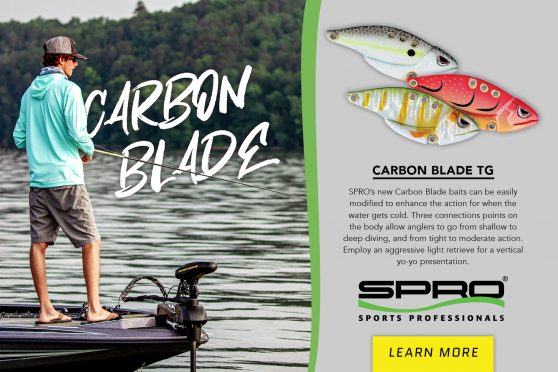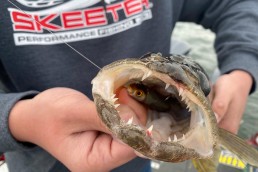The Cold-Water Walleye Bite
SHARE THIS POST
 You can narrow down how to catch early-season walleyes on lakes to a couple of key tactics that Roger Cormier says will produce great results for you.
You can narrow down how to catch early-season walleyes on lakes to a couple of key tactics that Roger Cormier says will produce great results for you.
Minnesota’s Lake Mille Lacs, a 132,000-acre natural lake in the state’s central region, is a healthy and dynamic walleye fishery that also maintains a tremendous population of smallmouth bass. The lake boasts many miles of shallow shorelines providing anglers with lots of options for catching both species during the early season.
A variety of structural elements add to the mix and expand an angler’s horizons as far as where and how to catch them. Near-shore areas from 3 to 12 feet deep offer a blend of sand riffles, gravel and rubble, larger boulders and weed lines that hold walleyes shallow for several weeks after the spawn. This same rock and gravel structure attracts and holds smallmouth that utilize these areas to spawn as well, usually a month or so after the walleye spawn and generally coinciding with the next full moon phase. The combination of so much ideal structure and the presence of two top gamefish make Mille Lacs a prime early-season destination for anglers from across the upper Midwest.
It’s hard to beat a jig-n-minnow combo from the early May opener through early June, no matter where you fish for walleyes. If you choose this presentation on Mille Lacs—or more specifically, choose a jig-n-shiner minnow—you’re assured of excellent results when fishing that 3- to 12-foot range. Most days, select bright colors for the jigs you cast (watermelon, parrot, or blue/green/pink glow, or UV patterns), pairing a 1/4-ounce jig-n-shiner with a 6-foot, 3-inch to 6-foot, 8-inch medium-power, extra-fast-action spinning rod like St. Croix’s Eyecon (EYS68MXF), 6-pound Sufix 832 Braid, and either 8- or 10-pound Sufix Advance Fluoro leader. You can’t get away with using 6-pound on a lake with zebra mussels; with repeated casts and catching lots of walleyes, it doesn’t hold up as well and you risk breaking off too many fish if you don’t retie often.
These days, many anglers forego cold hands in a minnow bucket and opt for soft plastic trailers instead of meat on the hook, and deservedly so; small swimbaits are deadly on shallow, cold-water walleyes. Two of my favorites are Storm’s 360GT Searchbait and the Largo Shad. The Searchbait comes pre-rigged with a rattling head, extra stout hook, and features a super durable plastic body. I’m usually able to catch 15 to 20 fish before needing to replace the plastic. Choose 3.5- and 4.5-inch sizes for Mille Lacs walleyes and smallies in May and June; the smelt and herring patterns have proven themselves on this fishery over time.
Rig a 3- or 4-inch Largo Shad on VMC’s Hybrid Swimbait Jig that features a corkscrew baitkeeper to keep the plastic pinned to the jighead. Then, for either of these lures, it’s as easy as casting them out and slowly reeling/dragging them back to the boat. Both walleyes and bass will smash these artificial offerings, and most days, they’ll out-fish live bait! An added benefit is far less downtime, because you can catch multiple fish on plastics compared to needing to rebait a jig-n-minnow after virtually every catch.
Are you enjoying this post?
You can be among the first to get the latest info on where to go, what to use and how to use it!
The jerkbait bite can get hot from the first cast on opening day. Working a jerkbait across expansive shallow gravel, rubble and sand flats—or along the edges of a shallow rock reef—is a great way to cover lots of ground to contact schools of walleyes holding in shallow water. If you are fishing exclusively with live bait or even with swimbaits, you must fish much more methodically to effectively work these presentations. You simply cannot cover as much water quickly with a jig as you can with a jerkbait. If you wish, once you contact fish with the hardbait, switch back to a jig or swimbait and thoroughly fish the area.
I always have at least two jerkbaits tied on and ready to cast on Mille Lacs in May: a #10 X-Rap and #11 Shadow Rap Deep. Always experiment with colors because the fish will change preferences from day-to-day and even hour-to-hour. Bright days and cloudy days add a variable that makes one color produce and another lose steam. Some good choices on Mille Lacs for jerkbait colors are Gold, Hot Steel, Silver and Yellow Perch for X-Raps and Bud, Halloween and Olive Green for Shadow Raps.
Decades ago, I cut my teeth fishing jerkbaits like the Husky Jerk on a 6-foot, 6-inch baitcasting rod and 10-pound line, but these days a more forgiving spinning rod like a 6-foot, 8-inch to 7-foot, 2-inch medium-fast or extra-fast (for example, St. Croix’s Avid or AVS68MXF orAVS70MF) is ideal for jerkbaits with sticky-sharp trebles. It’s personal preference whether you spool up with 8-pound fluoro or 6-pound braid paired with an 8-pound fluoro leader; some folks prefer some stretch on the hookset as well as during the fight, and you lose that flexibility with braid. The trade-off with braid is it’s much easier to cast repeatedly than fluorocarbon line that’s spooled on a spinning reel.
Because it’s one of Minnesota’s premier fishing destinations, it’s never too early to start planning your trip to Lake Mille Lacs!
Want more useful walleye fishing insight? You’ll find plenty of suggestions in every issue of MidWest Outdoors, available by subscribing on our website.
MWO
SHARE THIS POST
You may also like...
Nothing found.
Did you enjoy this post?
You can be among the first to get the latest info on where to go, what to use and how to use it!
